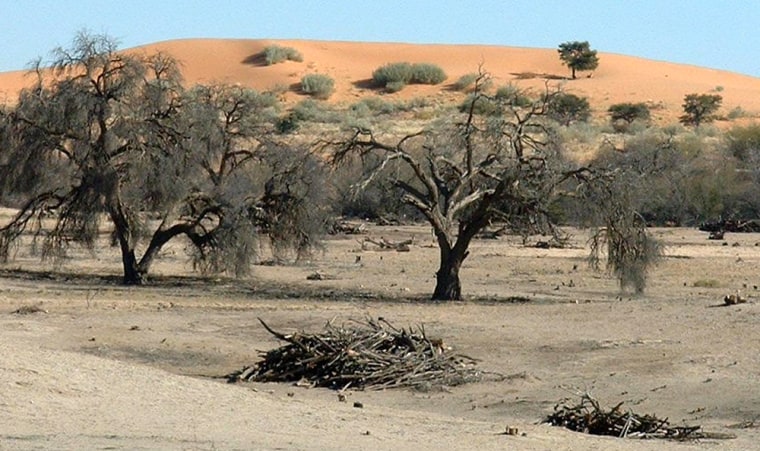Global warming could drastically alter Africa’s southern sand dune systems, spreading desert-like conditions and destroying the livelihoods of hundreds of thousands of people before the end of the century, new research warns.
Large parts of interior southern Africa stretching from northern South Africa to Angola, Zambia and beyond are made up of stabilized sand dunes. They are at least partially covered in vegetation and support a growing population of herders and farmers.
But research presented in June in the scientific journal Nature predicts widespread reactivation of these dunes as average rainfall declines, droughts increase and wind strengths pick up in the coming decades — conditions last seen 14,000-16,000 years ago.
The research is published as British Prime Minister Tony Blair prepares to host the Group of Eight summit focusing on African issues and climate change.
The study, conducted by British-based researchers David Thomas, Giles Wiggs and Melanie Knight, considered a number of different scenarios for climate change and emissions levels.
Life could be 'very difficult' by 2070
“By the time you get to 2070, regardless of the model used, you get a landscape that is more desert-like than today,” Thomas said. “Life will potentially be very difficult.”
The movement of dunes is driven by two key environmental factors: wind strength and the dunes’ susceptibility to erosion, which in turn is influenced by the level of rain fall and vegetation cover.
Based on observed dune activity over 20 years of fieldwork in the Kalahari region, the team was able to simulate how three dune fields would respond to different climate scenarios and a range of possible emission levels, Thomas said.
There are widespread predictions that the coming decades will see increased drought and wind in this region, accompanied by an overall decline in rainfall, though punctuated with incidents of extreme rainfall in some areas.
But even if moisture levels increase, they will be balanced by heightened evaporation as temperatures warm, and the dune fields will progressively become exposed and start moving, Thomas argued.
Shifts by 2039?
The researchers predict this would happen first — possibly as soon as 2039 — in the southern, driest areas and spread progressively northward, reaching into northern Botswana, eastern Namibia and western Zimbabwe and western Zambia by 2069.
The southern dune field has only partial vegetation cover and has already reactivated in areas — the ridges and troughs undulating with the wind in an every changing topography — during recent droughts. But what the research suggests is different, Thomas said.
“It is region-wide expansion of dune activity, with a long lasting drying and enhanced sand transport in windy months. As the land dries out, so plants die ... and then the wind, if there is enough energy, can pick the sand up and the dunes start to mobilize,” he said.
The effect is likely to be most dramatic in the eastern and northern fields.
Caution on models
This study, like others before it, highlights the potential for dramatic change in the African landscape, said Martin Todd of the Department of Geography at University College, London.
But while there is broad agreement that temperatures will rise in Africa, he cautioned there remains significant uncertainty about the outcome on particular processes such as vegetation cover and dune movements.
“There is a lot of uncertainty about how well our models can simulate things like precipitation and wind speed, on which this particular model depends,” Todd said.
Thomas and Wiggs are geomorphologists based at the Oxford University Center for the Environment. Knight is a dune activity modeler at the University of Salford’s Department of Earth and Life Sciences in Manchester.
